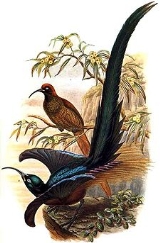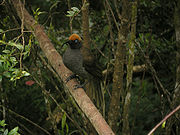
Brown Sicklebill
Encyclopedia
The Brown Sickbill, Epimachus meyeri is a large, up to 96 cm long, dark blue and green bird-of-paradise with highly iridescent plumages, a sickle-shaped bill, pale blue iris
and brown underparts. The male is adorned with ornamental plumes on the sides of its rear and a huge sabre
-shaped central tail feathers that are highly prized by natives. The female is a reddish brown bird with buff barred black below.
 The Brown Sicklebill is distributed to mountain forests of New Guinea
The Brown Sicklebill is distributed to mountain forests of New Guinea
, Its appearance resembles the closely related and larger Black Sicklebill
. In areas where these two large sicklebills met, the Brown Sicklebill replaced the latter species in higher altitudes. Its diet consists mainly of fruits, arthropods and small animals.
This bird was discovered by Carl Hunstein
in 1884 and named after Adolf Bernard Meyer
of Dresden
Museum, Germany
.
The Brown Sicklebill is evaluated as Least Concern on the IUCN Red List
of Threatened Species. It is listed on Appendix II of CITES.
Iris (anatomy)
The iris is a thin, circular structure in the eye, responsible for controlling the diameter and size of the pupils and thus the amount of light reaching the retina. "Eye color" is the color of the iris, which can be green, blue, or brown. In some cases it can be hazel , grey, violet, or even pink...
and brown underparts. The male is adorned with ornamental plumes on the sides of its rear and a huge sabre
Sabre
The sabre or saber is a kind of backsword that usually has a curved, single-edged blade and a rather large hand guard, covering the knuckles of the hand as well as the thumb and forefinger...
-shaped central tail feathers that are highly prized by natives. The female is a reddish brown bird with buff barred black below.

New Guinea
New Guinea is the world's second largest island, after Greenland, covering a land area of 786,000 km2. Located in the southwest Pacific Ocean, it lies geographically to the east of the Malay Archipelago, with which it is sometimes included as part of a greater Indo-Australian Archipelago...
, Its appearance resembles the closely related and larger Black Sicklebill
Black Sicklebill
The Black Sicklebill, Epimachus fastuosus, is a large bird of paradise of midmountain forests of New Guinea. The male has black plumage with an iridescent green, blue and purple scale-like feathers, red iris, bright yellow mouth, long curved black bill, huge sabre-shaped tail and large erectile...
. In areas where these two large sicklebills met, the Brown Sicklebill replaced the latter species in higher altitudes. Its diet consists mainly of fruits, arthropods and small animals.
This bird was discovered by Carl Hunstein
Carl Hunstein
Carl Hunstein was a German administrator, ornithologist and plant collector.Hunstein was born in Homberg/Efze, Germany...
in 1884 and named after Adolf Bernard Meyer
Adolf Bernard Meyer
Adolf Bernard Meyer was a German anthropologist, ornithologist and entomologist.-Biography:...
of Dresden
Dresden
Dresden is the capital city of the Free State of Saxony in Germany. It is situated in a valley on the River Elbe, near the Czech border. The Dresden conurbation is part of the Saxon Triangle metropolitan area....
Museum, Germany
Germany
Germany , officially the Federal Republic of Germany , is a federal parliamentary republic in Europe. The country consists of 16 states while the capital and largest city is Berlin. Germany covers an area of 357,021 km2 and has a largely temperate seasonal climate...
.
The Brown Sicklebill is evaluated as Least Concern on the IUCN Red List
IUCN Red List
The IUCN Red List of Threatened Species , founded in 1963, is the world's most comprehensive inventory of the global conservation status of biological species. The International Union for Conservation of Nature is the world's main authority on the conservation status of species...
of Threatened Species. It is listed on Appendix II of CITES.

